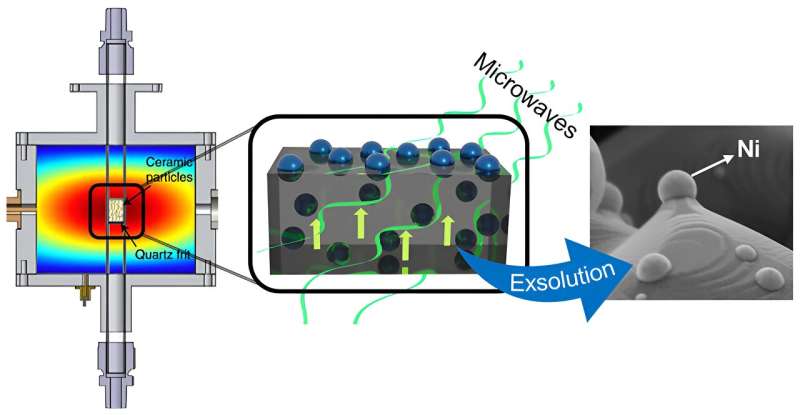
A team of researchers from the ITACA Institute of the Universitat Politècnica de València (UPV) and the Research Institute of Chemical Technology, a joint center of the Spanish National Research Council (CSIC) and the UPV, has discovered a new method for the manufacture of metal nanocatalysts that is more sustainable and economical.
With great potential in the industrial sector, the method would contribute to the decarbonization of industry. The work has been published in the journal ACS Nano.
This new method is based on the exsolution process activated by microwave radiation. Exsolution is a method of generating metallic nanoparticles on the surface of ceramic materials. “At elevated temperatures and in a reducing atmosphere (usually hydrogen), metal atoms migrate from the structure of the material to its surface, forming metal nanoparticles anchored to the surface. This anchoring significantly increases the strength and stability of these nanoparticles, which positively impacts the efficiency of these catalysts,” explains Beatriz García Baños, a researcher in the Microwave Area of the ITACA Institute at the UPV.
In the study, the UPV and CSIC researchers have shown that thanks to microwave radiation, this process can be carried out at more moderate temperatures and without the need to use reducing atmospheres.
“In this way, active nickel nanocatalysts can be produced in a more energy-efficient exsolution process. These catalysts have been proven to be active and stable for the reaction of CO production from CO2, obtaining a product of industrial interest and contributing to the decarbonization of the sector,” says Alfonso Juan Carrillo Del Teso, researcher of the Energy Conversion and Storage Group of the ITQ.
The exsolution process demonstrated in nickel nanoparticles has been carried out at temperatures of about 400ºC and exposure times of a few seconds, whereas the conventional exsolution procedure in these materials occurs at temperatures of 900ºC, with times of about 10 hours. In addition, this technology allows exsolution to be performed without using hydrogen.
“For all these reasons, we improve the sustainability of the process. Moreover, by obtaining the catalysts at milder temperatures and shorter exposure times, we reduce the costs of the process, which is also influenced by not having to use hydrogen as a reducing gas,” adds Beatriz García Baños.
Applications
The process developed by the UPV and CSIC team is primarily intended for high-temperature catalytic procedures for storing and converting renewable energy. It could also be applied to biogas reforming reactions for the production of synthesis gas (precursor of liquid fuels), CO2 hydrogenation reactions applicable to Power-to-X systems, and functionalizing electrodes for fuel cells and/or high-temperature electrolyzers.
More information:
Andrés López-García et al, Microwave-Driven Exsolution of Ni Nanoparticles in A-Site Deficient Perovskites, ACS Nano (2023). DOI: 10.1021/acsnano.3c08534
Journal information:ACS Nano
Provided by
Universitat Politècnica de València

READ MORE
Why Do Tires Blow Out More in Summer?
Summer is informally known as “blowout season.” Pxhere/CC0 Public Domain It’s not unusual to see [...]
Most massive stellar black hole in the Milky Way discovered ‘extremely close’ to Earth
Astronomers found the most massive stellar-mass black hole in the galaxy after spotting a star [...]
How Evolution Helps Us Understand and Treat Cancer
Micrograph of a well-differentiated papillary mesothelioma Wiki Commons / Nephron President Nixon declared the “War [...]
5 Tips for Disinfecting After Getting Rid of Mice
Mice can leave behind a lot of nasty and dangerous germs. Stockbyte/Thinkstock Eek! You’ve got [...]
Cell mechanics research is making chemotherapy friendlier
Element with a sampling probe (highlighted) in the atomic force microscope (AFM) at the Spectroscopic [...]
How do I find out the VOC content of paint?
You can get any color your heart desires in low- or no-VOC paint! Pixland/Thinkstock These [...]
Wyatt Earp Wasn’t the Fastest Gunslinger in the West and That Didn’t Matter
Wyatt Earp may not have been the fastest gunslinger in the West, but he was [...]
Amethystine Python: Australia’s Largest Native Snake
The amethystine python (Morelia amethistina) is a nonvenomous but nontheless lethal hunter lurking in Northern [...]